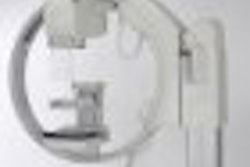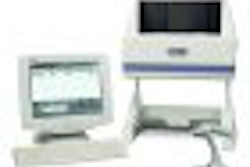Computer-aided detection (CAD) technology may improve the breast cancer detection rate for full-field digital mammography (FFDM) and film-screen mammography exams in facilities employing double reading, according to research published in the February issue of the American Journal of Roentgenology.
"Our results indicate that CAD has the potential for increasing the cancer detection rate, even in breast cancer screening programs using independent double reading," wrote a research team from Ullevaal University Hospital in Oslo, Norway (American Journal of Roentgenology, February 2007, Vol. 188:2, pp. 377-384).
To evaluate the performance and potential contribution of CAD to independent double reading of paired film-screen and FFDM screening mammograms, the researchers evaluated 3,683 women who received both FFDM and film-screen mammography between January 3 and June 22, 2000. The patients were followed for two years to include cancers detected between screening rounds and cancers detected at the next screening round, according to the researchers.
The women, with a mean age of 58, received film-screen mammograms using one of two Mammomat 300 systems (Siemens Medical Solutions, Erlangen, Germany), while FFDM images were acquired on a Senographe 2000D system (GE Healthcare, Chalfont St. Giles, U.K.).
The researchers then divided eight radiologists, all with more than four years of screening mammographic experience, into two teams. One team interpreted film-screen mammograms, while the other team evaluated the FFDM studies for one week; each team alternated weekly between film-screen mammography and FFDM interpretations. Two radiologists in each group independently interpreted the exams.
During the study, 55 biopsy-proven cancers were found, including 29 baseline cancers (an additional two were excluded from the analysis), 10 interval cancers, and 16 cancers detected at the second screening round. For the purposes of the study, the interval cancers and the cancers detected at the second screening round were considered to be subsequently diagnosed cancers.
The baseline mammograms of these cancer cases were evaluated using ImageChecker v8.0 (R2 Technology, Sunnyvale, CA). The areas marked by the CAD system were then assessed by the consensus panel to determine whether the location and characterization corresponded to the mammographically detected cancer.
CAD correctly marked 93% (27/29) of the cancers detected on the baseline images, and correctly marked all seven cancers missed in double reading of the FFDM cases, according to the researchers.
In 10 of the 26 cases of subsequently diagnosed cancers, the cancer was retrospectively judged to be visible and actionable. CAD marked 60% (6/10) of these cases on film-screen mammograms, and 100% (10/10) on the FFDM cases.
While CAD showed a slightly improved performance compared with double reading in film-screen exams (33/39 versus 30/39), CAD yielded a significantly increased sensitivity of 95% (37/39) in FFDM studies. In comparison, double reading only identified 64% (25/39) (p = 0.006).
CAD also correctly marked five cancers on film-screen mammography, as well as all cancers on FFDM that were not detected during prospective independent double reading, according to the authors.
"An interesting finding was that on FFDM, CAD marked all 14/39 (36%) malignant lesions not recalled at independent double reading, potentially increasing the cancer detection rate 36% and reaching a 100% combined detection rate for these 39 cancers," they wrote.
The findings show that CAD offers the potential for increasing breast cancer detection, the researchers concluded.
"Furthermore, our results indicate that CAD may be of particular value when FFDM with soft-copy reading is introduced into breast cancer screening programs," they wrote.
By Erik L. Ridley
AuntMinnie.com staff writer
February 2, 2007
Related Reading
CMS looks to cut CAD reimbursement, December 8, 2006
Digital mammography: Not just plug-and-play, October 23, 2006
CAD boosts single reading of mammograms, September 29, 2006
Multimodality breast CAD workstation improves diagnostic performance, August 17, 2006
Take care when coding for digital mammography and CAD, July 13, 2006
Copyright © 2007 AuntMinnie.com



















